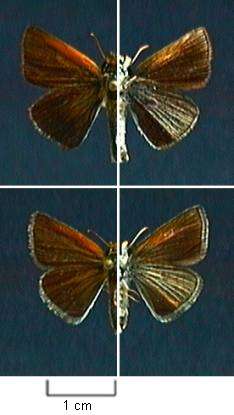Oarisma Poweshiek on:
[Wikipedia]
[Google]
[Amazon]
''Oarisma poweshiek'', the Poweshiek skipperling, is a North American
Butterflies of Canada

''Oarisma poweshiek''.
NatureServe Explorer.
Paradoxes of Poweshiek Skipperling (''Oarisma poweshiek'') (Lepidoptera: Hesperiidae): Abundance patterns and management of a highly imperiled prairie species.
''ISRN Entomology'' 2014 216427. {{Authority control Butterflies of North America ESA endangered species Hesperiinae Butterflies described in 1870
butterfly
Butterflies are winged insects from the lepidopteran superfamily Papilionoidea, characterized by large, often brightly coloured wings that often fold together when at rest, and a conspicuous, fluttering flight. The oldest butterfly fossi ...
in the family Hesperiidae
Skippers are a group of butterflies placed in the family Hesperiidae within the order Lepidoptera (moths and butterflies). They were previously placed in a separate superfamily, Hesperioidea, but have since been placed in the superfamily Papilion ...
(skippers), subfamily Hesperiinae
Grass skippers or banded skippers are butterflies of the subfamily Hesperiinae, part of the skipper family, Hesperiidae. The subfamily was established by Pierre André Latreille in 1809.
Description and distribution
With over 2,000 described sp ...
(grass skippers). The range of this species in Canada is restricted to southeastern Manitoba
Manitoba is a Provinces and territories of Canada, province of Canada at the Centre of Canada, longitudinal centre of the country. It is Canada's Population of Canada by province and territory, fifth-most populous province, with a population ...
, and in the United States it historically ranged from the Dakotas
The Dakotas, also known as simply Dakota, is a collective term for the U.S. states of North Dakota and South Dakota. It has been used historically to describe the Dakota Territory, and is still used for the collective heritage, culture, geo ...
to the southern Lower Peninsula of Michigan
The Lower Peninsula of Michigan – also known as Lower Michigan – is the larger, southern and less elevated of the Geography of Michigan, two major landmasses that make up the U.S. state of Michigan; the other being the Upper Peninsula of Mic ...
.
Description
Coloured dark brown on the upperside with an orange along the costa. The underside of the hindwings are dark grey with white veins. Wingspan is from 24 to 30 mm.Poweshiek SkipperlingButterflies of Canada
Behaviour
The Poweshiek skipperling emerges in late June or early July and exists in the adult form for approximately a two-week period. During this time the skipperling nectars on a suite of flowers, mates and lays eggs. The larvae feed ongraminoid
In botany and ecology, a graminoid refers to a herbaceous plant with a grass-like morphology, i.e., elongated culms with long, blade-like leaves. They are contrasted with forbs, herbaceous plants without grass-like features.
The plants most ...
plant species that possibly vary throughout the distribution of this species.

Conservation status
The Poweshiek skipperling was a common prairie butterfly prior to 2005, but suffered a population crash between 2005 and 2015. The Poweshiek skipperling has a NatureServe ranking of G1 or critically imperiled. It is threatened by degradation and modification of its native prairie habitat byovergrazing
Overgrazing occurs when plants are exposed to intensive grazing for extended periods of time, or without sufficient recovery periods. It can be caused by either livestock in poorly managed agricultural applications, game reserves, or nature ...
, invasive species, and conversion to cropland.U.S. Fish and Wildlife Service. 2014, October 24. Endangered and Threatened Wildlife and Plants; Threatened Species Status for Dakota Skipper and Endangered Species Status for Poweshiek Skipperling. Federal Register. This species was awarded endangered status under the United States Endangered Species Act
The Endangered Species Act of 1973 (ESA; 16 U.S.C. § 1531 et seq.) is the primary law in the United States for protecting and conserving imperiled species. Designed to protect critically imperiled species from extinction as a "consequence of e ...
in 2014 after gaining candidate status in 2011. The Poweshiek skipperling was assessed as threatened by Committee on the Status of Endangered Wildlife in Canada
The Committee on the Status of Endangered Wildlife in Canada (COSEWIC, French: Comité sur la situation des espèces en péril au Canada, COSEPAC) is an independent committee of wildlife experts and scientists whose "raison d'être is to identify s ...
(COSEWIC) in 2003, then, in 2005, the species was added to Schedule 1 with the status threatened under the Species at Risk Act
The ''Species at Risk Act'' (, SARA) is a piece of Canadian federal legislation which became law in Canada on December 12, 2002. It is designed to meet one of Canada's key commitments under the International Convention on Biological Diversity. T ...
(SARA), in Canada. In 2014, the species was reassessed as endangered by COSEWIC. In February 2019, the SARA status was changed to endangered.
In 2018, the Minnesota Zoo
The Minnesota Zoo (formerly the Minnesota Zoological Garden) is an Association of Zoos and Aquariums, AZA-accredited zoo in Apple Valley, Minnesota. The zoo is one of two state-supported zoos in the United States, with the other being the North Ca ...
began efforts to rear them in captivity, for release in the wild. In 2022, the Minnesota Zoo released over 100 individuals in to the wild.
References
External links
* *NatureServe. 2014''Oarisma poweshiek''.
NatureServe Explorer.
Further reading
*Swengel, A. B. and S. R. Swengel. (2014)Paradoxes of Poweshiek Skipperling (''Oarisma poweshiek'') (Lepidoptera: Hesperiidae): Abundance patterns and management of a highly imperiled prairie species.
''ISRN Entomology'' 2014 216427. {{Authority control Butterflies of North America ESA endangered species Hesperiinae Butterflies described in 1870